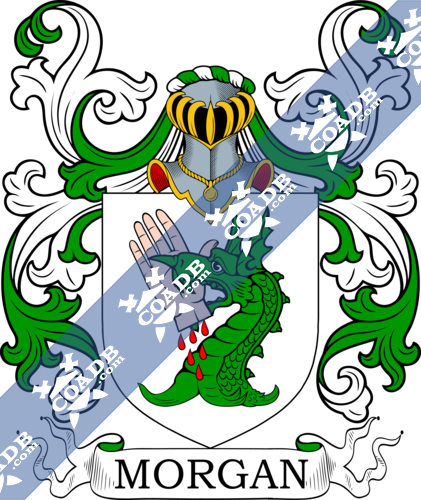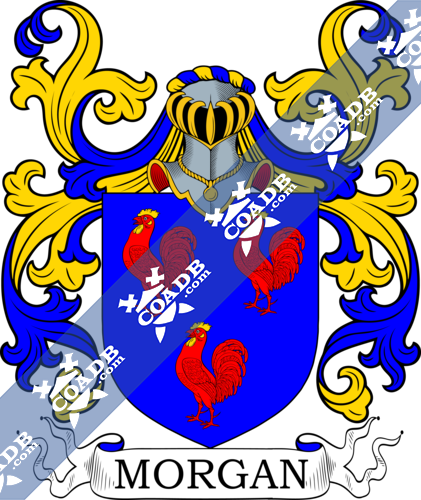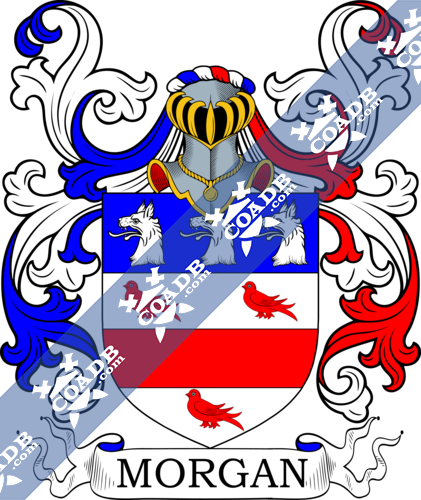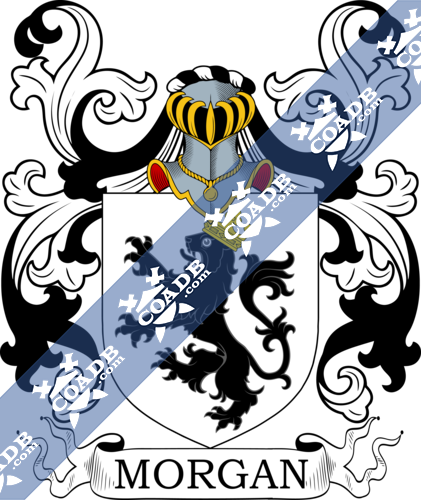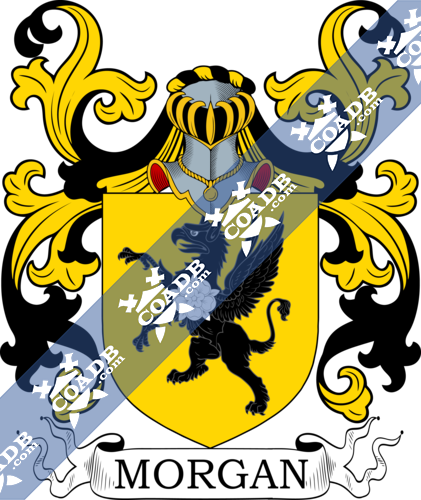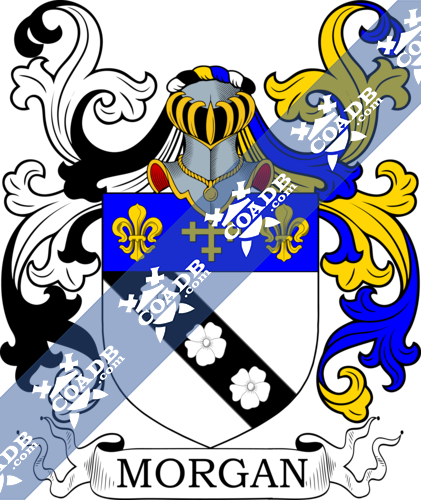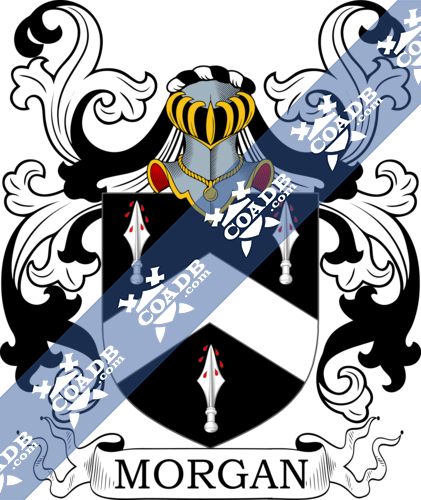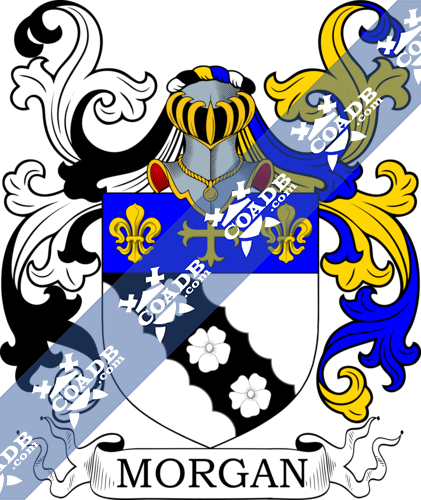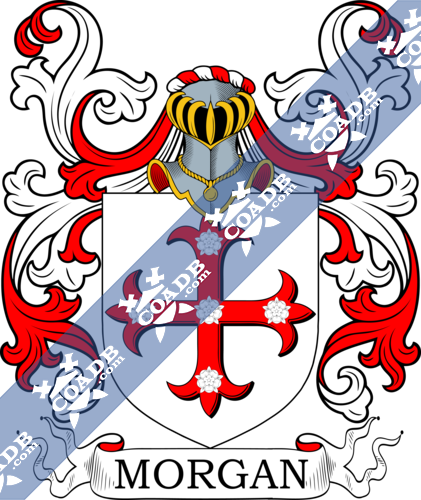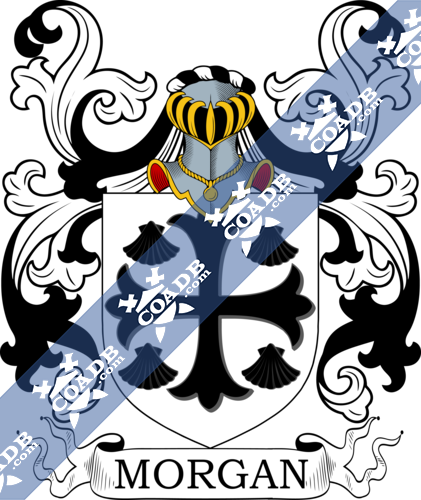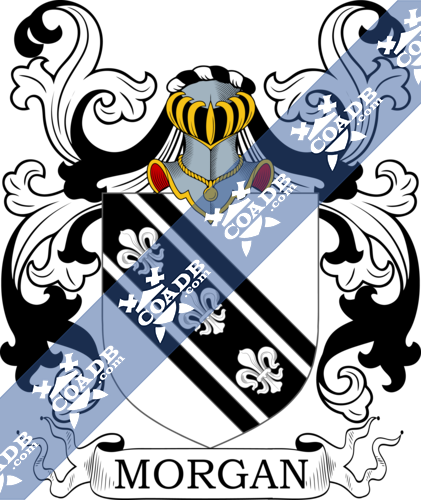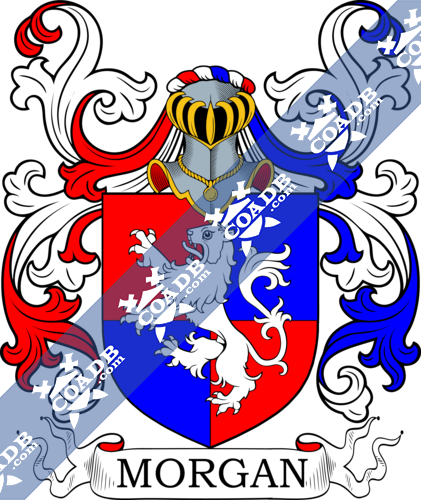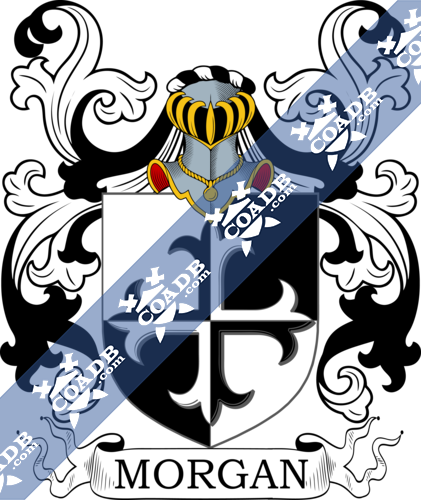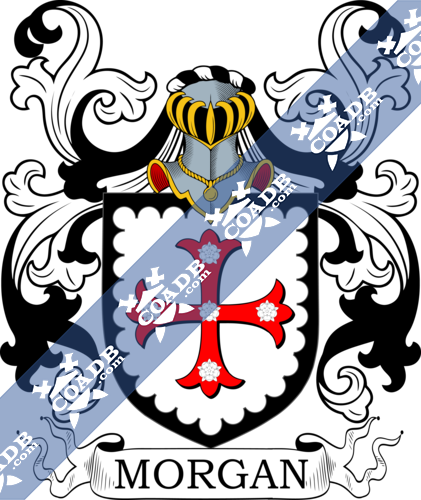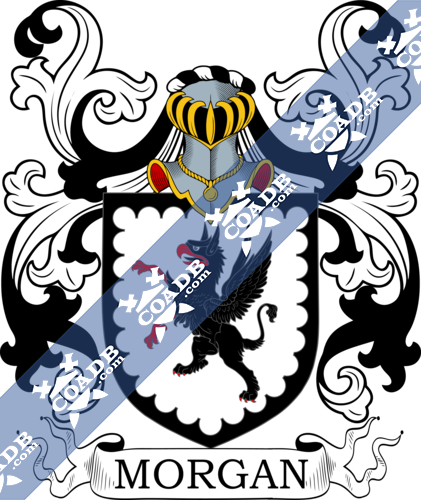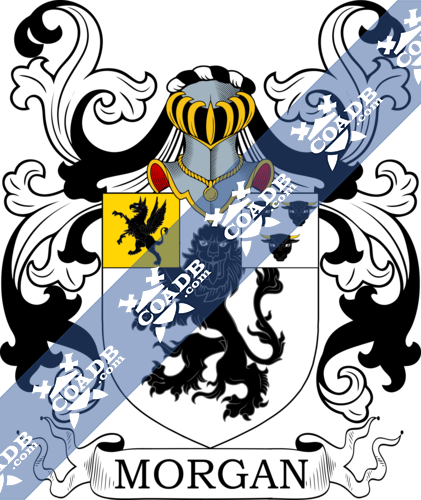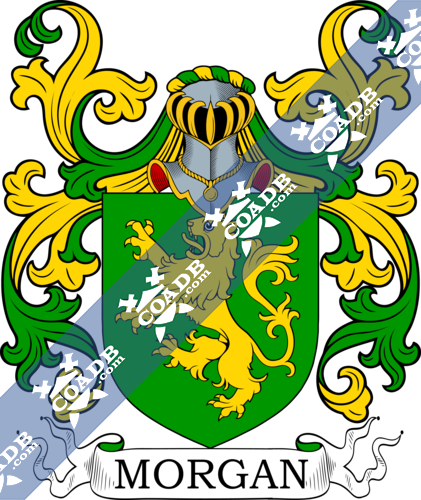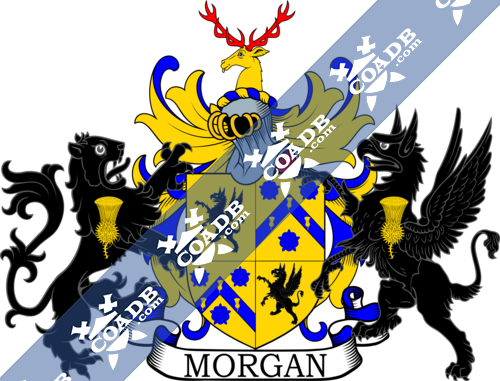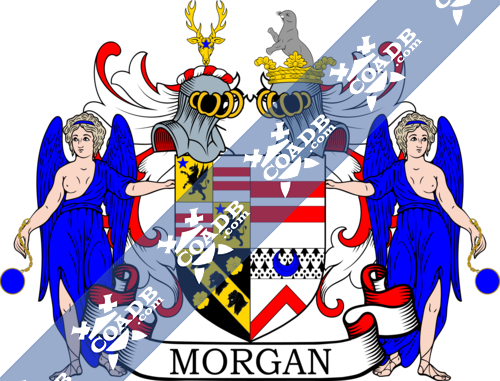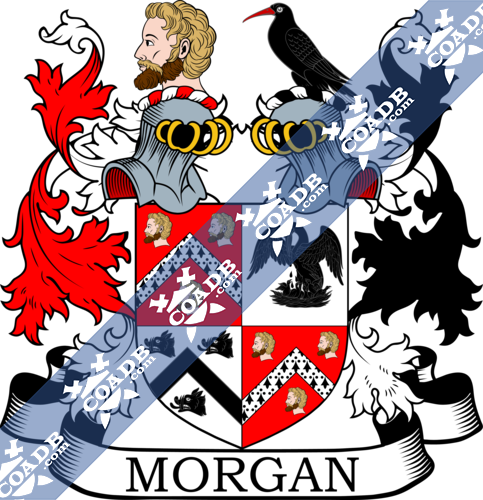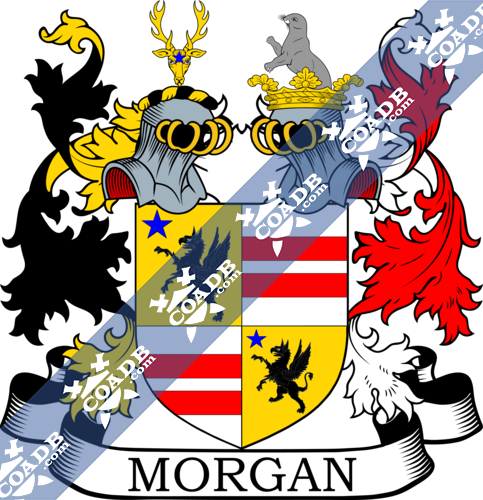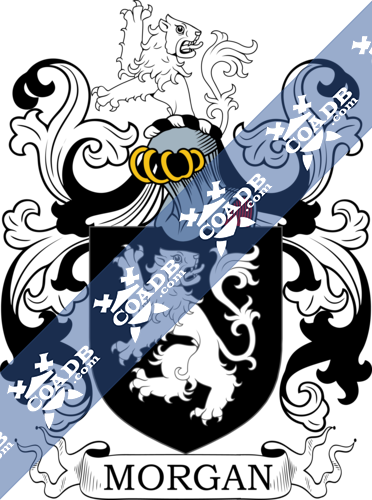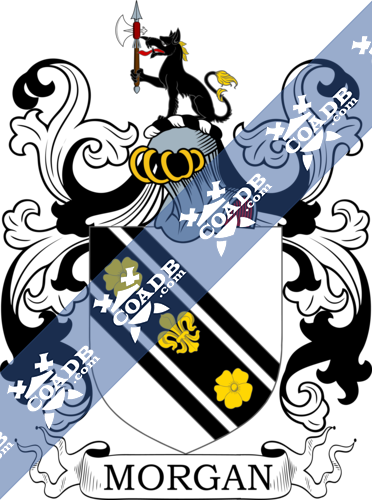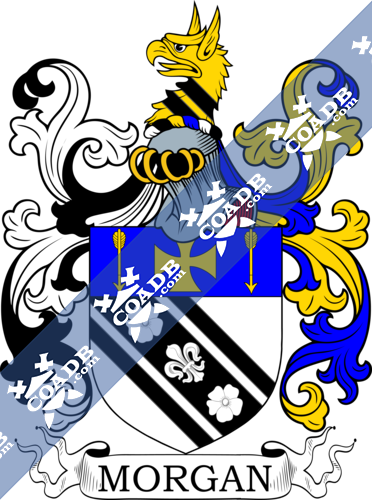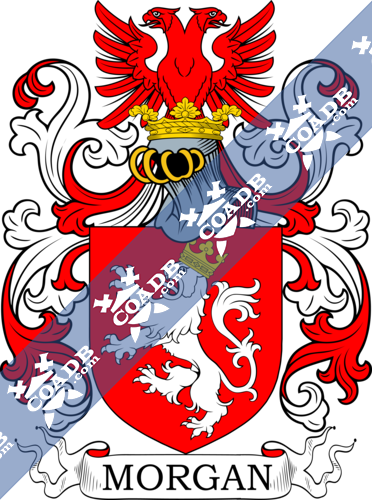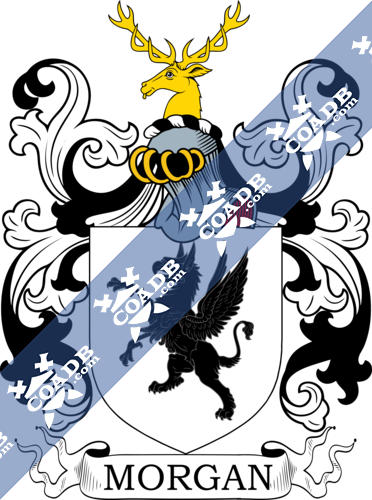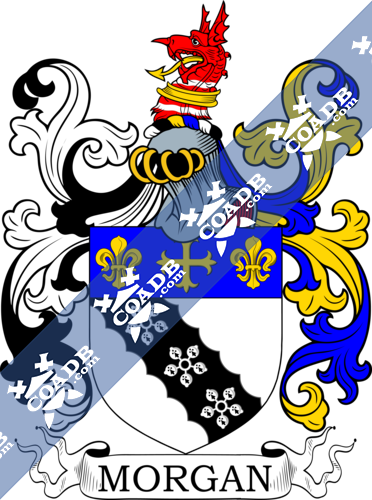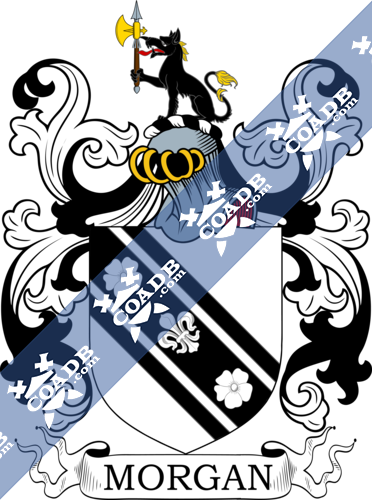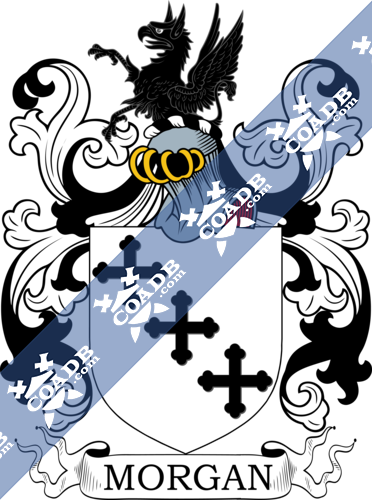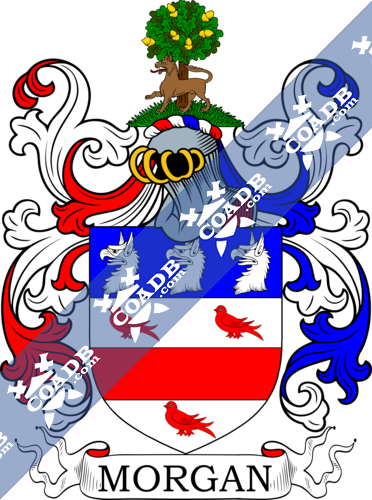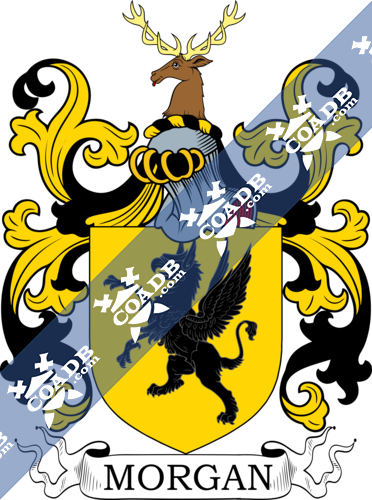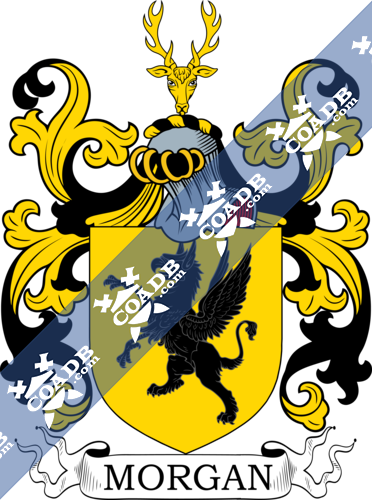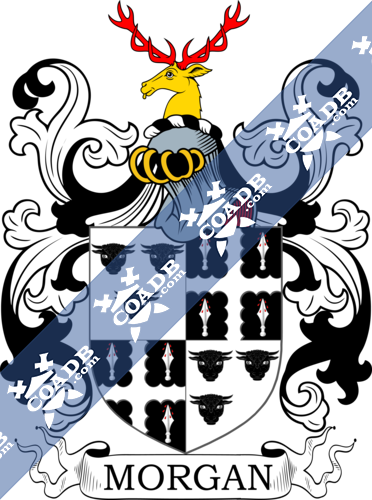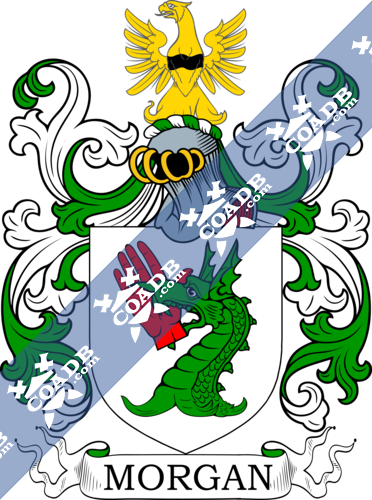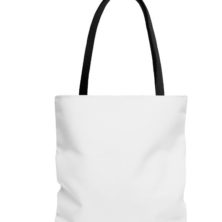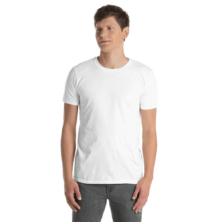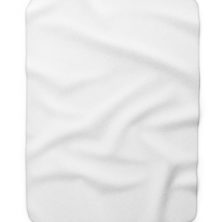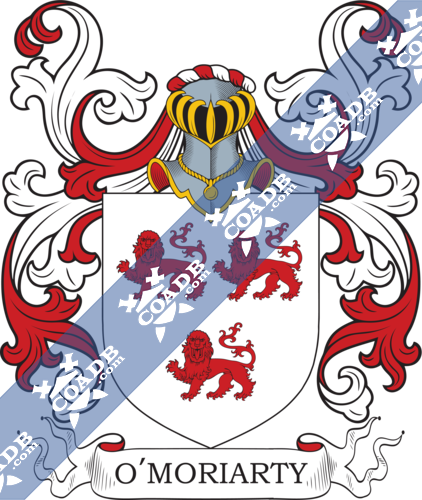Morgan Family Crest, Coat of Arms and Name History
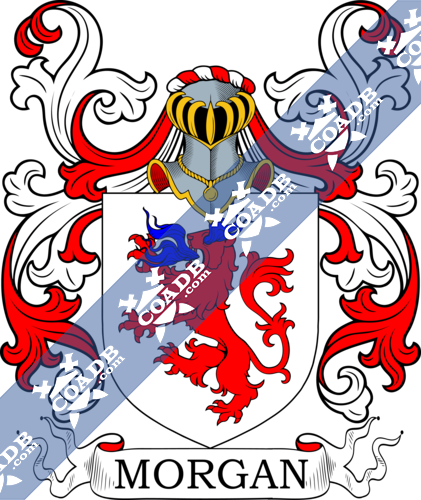
Morgan Coat of Arms Gallery
Don’t know which Coat of Arms is yours?
We can do a genealogical research. Find out the exact history of your family!
Learn MoreMeaning, Origin, Etymology
The surname of Morgan has roots in both Gaelic and Celtic languages. The original spelling of this surname comes from the personal name of “Morcant” and was changed to “Morgan” in medieval times. This surname can be translated to mean “chief of the sea” or “defender of the sea.” It comes from the Welsh components of “mor” which can be translated to mean “sea” and “cant” which can be converted to mean “circle.” The definite meaning of this surname is widely debated, but most can agree on “defender of the sea.” The feudal spelling of Morgan comes from the elements “mor” which can be translated to mean “sea” and “gan” which can be deciphered to mean “born of.” Thus, all put together, it is commonly believed that the surname of Morgan literally translates to “born of the defender of the sea.” The first recorded spelling of the surname of Morgan can be found in the country of England. One person who was named John Morgan was mentioned in the Curia Regis Rolls of Berkshire in the year of 1214. This document was ordered, decreed, and written under the reign of King John I of England, who was commonly known as throughout the ages as one “The Lackland.” King John I of England ruled from the year of 1199 to the year 1216. Those who assume the surname of Morgan can be found in the areas of Herefordshire and Lancashire. The first recorded spelling of the surname of Morgan in the country of Scotland was in the year 1419. One person by the name of Jon Morgane was named as a burgess of Glasgow. Those who carry the surname of Morgan in the country of Scotland can be found in large concentrations in the areas of Fife, Aberdeenshire, and Glasgow. The surname of Morgan is one of the most prominent surnames in the country of Wales. The first recorded spelling of the surname of Morgan in Wales was in the year of 1538. One person by the name of Thomas Morgaine was mentioned as a Knight of Monmouth. The importance of the surname of Morgan is also realized in the name of the kingdom of Glamorgan, which is a form of “Ap Morgan” which can be loosely translated to mean “the son of Morgan.” Those who bear the surname of Morgan are found in large concentrations throughout the country of Wales. The areas that have the largest population of those people who have the surname of Morgan are within the counties of Glamorgan, Carmarthenshire, Montgomeryshire, Radnorshire, and Monmouthshire. The first recorded spelling of the surname of Morgan in the country of Ireland appears in the year of 1654. One person by the name of Edward Morgane was mentioned as living in the city of Dublin, Ireland on April 26th of the year 1654. The areas where those who are known by the surname of Morgan are most prominent are in Leinster and Ulster. During the European Migration many European citizens moved to America. The first person with the surname of Morgan to arrive was Benedict Morgan, who settled in Plymouth, Massachusetts in the year 1621.
Spelling Variations
Morgans, Morgain, Moragan, Morigan, Morgane, Morgana, Morghan, Morgani, Morgano, Morogan, Moorgan,
Popularity & Geographic Distribution
The last name Morgan ranks 829th in popularity worldwide as of the 2014 Census and approximately 646,526 people carry the surname worldwide. The name ranks particularly high in the following six states: Texas, California, Florida, North Carolina, Georgia and New York. It ranks highest in the following countries: United States, England, Wales, Australia, Canada and Jamaica.
Early Bearers of Surname
A few of the earliest bearers of the Morgan surname were Graecized as Pelagius. Morgrun, comes de Mar, 1214—49 (RPSA., p. 363), Morgund, son of John Abbe, 1204—11 (RAA., I, 72) appears c. 1239 as Morgund filius Abbe, a lay abbot (Panmure, I, p. cliv), Morgund de Glenesk, of county of Forfare, rendered homage, 1296 (Bain, II, p. 199), John Morgane was burgess of Glasgow, 1419 (LCD., p. 241), John Murgounis, one of the tenants of Wester Micras (Mecray), 1539 (ER., XVII, p. 659).
History, Genealogy & Ancestry
MORGAN OF HENGWRTUCHA
Howel Morgan, Esq. of Henwrtucha in the County of Merioneth and Penawer County of Brecon who was a Justice of the Peace and D.L. for Counties Merioneth and Brecon and Justice of the Peace for County Montgomery and was named High Sheriff in 1863 he married Anne the 2nd daughter of Hugh Jones, Esq. of Hengwrtucha of the Counties of Merioneth, Plashen and Carnarron on September 13, 1860.
MORGAN OF GOLDEN GROVE
George Augustus Morgan, Esq. of Golden Grove in the County of Flint, Lieut-Col. in Her Majesty’s Service who served in the Ottoman Army 1854-55. He was first an Aide-de-Camp to Gen. Cannon, and then to Gen. Bentson and was then commanded a regiment of the Albanian Cavalry. He was born April 11, 1828 and married Emily the eldest daughter of Rev. J.T. Maine M.A. of Brighton Wood, Hants, on April 11, 1828. They had a son Edward Augustus Gwyllyn born February 12, 1851. George Augustus Morgan descended from the family that was seated in Golden Grove from a very early period in time. They descends from Ednyfed Vychan the Lord of Brynffenigl in Carnarvon who was a representative of Marcchudd AP Synan the founder of the VIIIth noble tribe of North Wales and Powys. He is the memorable progenitor of the royal House of Tudor. The 9th in descent from Sir Tudor AP Ednyfed Vychan was Edward Morgan, Esq. who assumed the family surname. He married Catherine the daughter of John Davies, Esq. of Gwysaney and they had issue. Their eldest son was Edward Morgan, Esq. of Golden Grove who practiced law who married Anne the daughter of John Conway, Esq. of Bodrhyddan and died February 25, 1611 and left a son and heir Robert Morgan, Esq. of Golden Grove he married Catherine the daughter of Sir William Jones of Castell-y-march and was succeeded at his death by his eldest son. Capt. William Morgan of Golden Grove married Eliza the daughter of Thomas Whitley, Esq. of Aston and they had a son and heir Edward Morgan, Esq who was slain at Winnington Bridge. He left a his wife Elizabeth the daughter of Thomas White, Esq. and a son and successor Edward Morgan, Esq. of Golden Grove who married Ursula the daughter of Sir Henry Bunbury, Bart of Stanney and had issue Edward who was his heir, Thomas a Captain at Barbados, William, Elizabeth, and Catherine who lived at Chester. He died in 1682 and was succeeded by his son Edward Morgan, Esq. of Golden Grove who was born 1669 and was High Sheriff 1701. He married Frances the daughter of William Bankes, Esq. of Winstanley Hall, in the County of Lancaster and the had a daughter Catherine who married Robert Bankes, Esq of Winstanley and a son Edward Morgan, Esq. of Golden Grove who was a High Sheriff in 1738, he married Anne the daughter and heir of Robert Crompton, Esq. of Kinnerton and Bache of the County Chester and died in 1749 who was succeeded by his son Peter Morgan. Peter Morgan, Esq. of Golden Grove who was High Sheriff in 1752 he married Margaret who was the daughter of John Hesketh, Esq. of Warrington and died 1780. He left a daughter Margaret who died unmarried and a son and successor Edward Morgan, Esq. of Golden Grove who was a Lieut.-Col. in the Flintshire Militia and was a High Sheriff in 1792. He was born August 7, 1759 and married Louisa the daughter and co-heiress of the late Thomas Griffith, Esq. of Rhual and had issue Edward, late of Golden Grove, Angustus Henry, Louisa Henrietta who married Richard Augustus Tucker Steward, Esq of Nottingham House. He died June 28, 1831 and was succeeded by his son Edward Morgan, Esq. of Golden Grove who was a Colonel of the Militia who was born April 1, 1793 and married 1st Charlotte the daughter of Col. Gwyllym Lloyd Wardle of Hartsheath Park in the same shire on February 14, 1827 and had a son George-Augustus now of Golden Grove. Colonel Morgan married 2nd Alice the daughter of John Douglas, Esq. of Gyrn in the County of Flint and had by her three sons. Arthur Edward the late Captain of the 71st Highlanders born August 16, 1838, Charles born February 19, 1843, Edwin born November 2, 1848. George-Augustus was in the Royal Fusilliers and participated in almost every action in the Peninsula and was severly wounded at the Battle of Albuera and died in 1861.
MORGAN OF BIDDLESDON PARK
James Morgan, Esq. who is from an old Carnarvonshire family of Lincoln’s Inn, Barrister-at-Law and was a Bencher of that Society who inherited considerable propery from his maternal uncle Erasmus Lewis, Esq. of Abercothy. He married Mary one of four daughters and co-heiresses of Charles Parry, Esq. of Oakfield Berks. They had issue George, William, John, Chardin, James, Mary and John. He was succeeded by his eldest son George Morgan, Esq. of Abercothy in the County of Carmarthen and Biddlesdon Park, Bucks who was born October 13, 1739 who married in 1792 Frances who was the daughter of William Mabbott of Bulmarsh Court near Reading and died June 10, 1819 and left issue George Manners his heir, William, Charles, Frederick and Edmund. The eldest son George Morgan, Esq. of Biddlesdon Park and of Abercothy in the County of Carmarthen. He was High Sheriff of the County of Carmarthen in 1824. He was born August 6, 1793 and married Anna Eliza the 4th daughter of George Laver Oliver, Esq. of Brill Park in the County of Buckingham in 1820. Their children were George Manners, Francis Frederick Richard Mansel and Chandos Stuart Temple Henry. He died in 1847.
DIRECTORY OF ANCESTRAL HEADS OF NEW ENGLAND FAMILIES 1620-1700
According to the ‘Directory of the Ancestral Heads of New England Families 1620-1700’ the following Morgan’s were Heads of Families in the early days of the American Colonies. Francis at Kittery, Maine 1664, James Morgan was born in Wales in 1607 and married in Roxbury, Massachusetts in 1640 then moved to New London, Connecticut sometime before 1657, another James Morgan was a resident of Boston, Massachusetts before 1676, Joseph Morgan was married at Lynn, Massachusetts in 1669, Miles who was the brother of James was born in Llandaff, Glamorganshire, Wales 1615 and came to Boston, Massachusetts in 1636 he them moved to Springfield, Massachusetts in 1643, Owen Morgan married at New Haven, Connecticut in 1650 and then moved to Norwalk, Connecticut, Richard was born in Wales and came to Portsmouth, New Hampshire sometime before 1658 then moved to Brentwood, New Hampshire about 1659, Robert was in Saco, Maine approx. 1636 and in Kennebec, Maine approx. 1665, another Robert Morgan was born in Wales in 1601 and was in Salem, Massachusetts as early as 1636, Roger Morgan died at Charlestown, Massachusetts in 1675, Samuel was a resident of Marblehead Massachusetts about 1674, and William Morgan lived in Amesbury, Massachusetts till about 1677 when he moved to New Hampshire.
COMPLETE AMERICAN ARMOURY AND BLUE BOOK 1907 EDITION
JAMES LANCASTER MORGAN 3rd of New York City the son of James Lancaster Morgan the 2nd and Alice M. Hill (the daughter of John J. Hill of Albany, New York) was born April 27, 1867 in Brooklyn, New York. He graduated from Columbia University in 1888 and married Maria Letitia Goodwin (the daughter of Hon. Alex. T. Goodwin of Utica, New York) on November 2, 1892. They had issue: 1) James Lancaster the 4th born July 24, 1893 and died September 14, 1894 2) Helen Ridgley born May 26, 1896. The lineage for this family is Charles and Elizabeth Morgan of Long Island 1683, James Morgan 1683-1764, Charles Morgan 1720-1760, Charles Morgan 1756-1833, Abijah Morgan 1783-1869. Arms-Vert, a lion rampant or; impaling (Goodwin) or, a lion passant guard. sable, on a chief gules three lozenges vaire. Crest- A reindeer’s head cabossed proper. Motto-Dum spior spero. Residences- 201 West 55th St. N.Y. City; Larchmont Manor, N.Y. Clubs- University, Larchmont Yacht, Chemists Societies- Colonial Wars, PSI Upsilon.
Early American Immigration and New World Settlers
There were quite a few early settlers with the surname of Morgan. Some of the earliest settlers to the America’s were Bennett Morgan who arrived in Plymouth, Massachusetts in 1621, Robert Morgan who arrived in Virginia in 1621, Benedict Morgan who arrived in Plymouth Massachusetts in 1621, Edmond Morgan who arrived in Virginia in 1623, Charles Morgan who arrived in Bermuda in 1625, Thomas Morgan who arrived in Virginia in 1626, Roger Morgan who arrived in Maryland in 1633, John Morgan who arrived in Virginia in 1635 and James Morgan who arrived in Roxbury, Massachusetts in 1640. Some of the earliest settlers to Canada include John Morgan who arrived in Toronto in 1824, Richard Morgan who arrived in Ontario in 1824, Thomas Morgan who arrived in Ontario in 1831, Kitty Morgan who arrived in New Brunswick in 1837, Margaret Morgan who arrived in Quebec in 1847, and Lydia Morgan who arrived in Ontario in 1861. A few of the Morgan’s that arrived on convict transports to Australia were Robert Morgan who arrived in Tasmania in 1852, Ann Morgan who arrived in New South Wales in 1803, David Morgan who arrived in New South Wales in 1834, Elizabeth Morgan who arrived in Tasmania in 1843, Charles Morgan who arrived in Tasmania in 1830 and William Morgan who arrived in New South Wales in 1809.
Mottoes
There are three mottoes identified for the surname of Morgan. 1) Audaces fortuna juvat. Fortune favours the bold. 2) Heb Dduw heb ddim, Duw a digon. Without God without anything, God is enough. 3) Honor et virtus. Honour and virtue.
Grantees
Some of the arms holders and their dates of acquiring the arms with the surname of Morgan are:
Henry Morgan of St. Davids acquired April 2, 1554
Hugh Morgan Apothecary to the Queen originally of Essex and London acquired March 2, 1587
John Morgan of Chester acquired December 4, 1608
Lewis Morgan of Grays Inn acquired July 3, 1656
Robert Morgan of Little Hallingbury Essex acquired 1613
Thomas Morgan of Eston Somerset acquired 1591
William Morgan Bishop of Llandaff acquired sometime between 1594 and 1601
William Morgan of Blackmore County of Hereford acquired May 27, 1602
Notables
A few of the notables that hold the surname of Morgan were William Moran (1930-2016) who was an author and an architect in America and won the Florida Award of Merit in 1964. Dennis Morgan (1952-2015) who was a running back in the NFL in 1974 and 1975. Jane Ann Morgan (1951-1988) who lived in London England and was an attorney. She died on Pan Am Flight 103 from Frankfurt to Detroit and is now called the Lockerbie Bombing in 1988. Linda J. Morgan was a Member of the Interstate Commerce Commission in 1994 and 1995.
American Revolution Veterans
The American Revolution, produced many valiant soldiers one of the more famous soldiers was Daniel Morgan (1736-1802). He was born in New Jersey to Welsh Immigrants and they had settled in Winchester Virginia. At the beginning of the American Revolution he joined the Virginia Militia and recruited a company of soldiers. He served under Benedict Arnold’s expedition to Quebec and in the Saratoga Campaign and the Philadelphia Campaign. After the Battle of Camden he led a troop from the Continental Army to the Battle of Cowpens which they were victorious. He retired from the army after the war onto a very large estate. He was called back to duty in 1794 for the Whiskey Rebellion. He ran for the United States House of Representatives and won the election in 1796. He retired from Congress in 1799 and died in 1802.
Civil War Veterans
Although the Civil War, had many brave soldiers on both sides, one of the men who served in the Civil War was John Hunt Morgan (1825-1864) who was a Confederate General. In April 1862 he was a General of the Kentucky Cavalry Regiment and he fought at Shiloh and participated in a raid that encouraged Braxton Bragg’s invasion of Kentucky. In July 1863 he left for a 1000-mile raid that went into Indiana and Ohio and took hundreds of prisoners along the way but was intercepted by Union gunboats and surrendered at Salineville, Ohio. This was the northernmost point ever reached by any uniformed Confederate’s. He was shot in the back and killed by Union cavalrymen at Greenville, Tennessee in September 1864, he was buried in the Lexington Cemetery and occurred shortly before his second child another daughter was born. The Morgan High School in McConnelsville, Ohio is located near the site where he crossed the Muskingum River and they named their mascot the Raiders after the campaign that was launched there. In Versailles, Indiana the South Ripley High School named their mascot the Raiders in honor of the campaign that was held across Indiana by Morgan. There is a statue of him in Lexington, Kentucky named John Hunt Morgan Memorial and, also in Lexington his home called Hunt-Morgan House is in a historic district there. In Greenville, Tennessee at the spot where he was killed the General Morgan Inn stands.
Blazons & Genealogy Notes
1) (Lord of Tredegar, co. Monmouth; the heiress, Angharad, conveyed Tredegar to her husband, Llewellin ap Ivor, Lord of St. Clere, ancestor of Morgan, of Tredegar). (ap Meredith). Ar. a lion ramp. gu. incensed az.
2) (Baron Tredegar). Quarterly, 1st and 4th, Morgan, or, a gryphon segreant sa.; 2nd and 3rd, Gould, or, on a chev. betw. three roses az. as many thistles slipped of the field. Crest—A reindeer’s head couped or, attired gu. Supporters—Dexter, a lion sa. charged on the shoulder with a thistle slipped or; sinister, a gryphon sa. charged in like manner with a thistle slipped or.
3) (Llantarnam Abbey, co. Monmouth, bart., extinct 1681; descended from William Morgan, Esq., of Llantarnam, High Sheriff of the county in 1567, and M.P. in 1571, son of John Morgan, Esq., of Caerleon, and grandson of Sir Thomas Morgan, Knt., of Pencoed, who was son of Morgan ap Jenkin, of Langston. Sir Edward Morgan, Knt., of Llantarnam, was created a bart. 1642; his grandson. Sir Edward Morgan, third and last bart., left two daus. his co-heirs; Anne, d. unm., Frances, m. Edmund Bray, Esq.). Ar. a griffin segreant sa.
4) (Tredunnock, co. Monmouth; descended from John Morgan, Esq., of Tredunnock, son of Morgan ap Jenkin, of Langston, by his third wife; represented by Hawkins, of Tredunnock). (Penllyne, co. Monmouth). Or, a griffin segreant sa. Crest—A reindeer’s head couped or, attired gu.
5) (Lansore, co. Monmouth). Motto—Y Droddefodd y orfy; and, Vincet qui patitur. Ar. three bulls’ heads cabossed sa., quartering, Sa. a cross engr. ar. betw. four spearheads of the last, points embrued, for Prosser, of Lansore. Crest—A reindeer’s head couped or, attired gu.
6) (Pencrug, co. Monmouth; represented by Mackworth, Bart., of Glen Usk). Ar. a wivern’s head erased vert, holding in the mouth a hand couped gu. Crest—A demi eagle displ. or, charged on the body with a fess wavy sa.
7) (Llangattock, co. Monmouth, bart., extinct 1767; Sir Thomas Morgan, of Llangattock, a celebrated parliamentary leader, was created a bart. 1661; he and Sir Henry Morgan, Governor of Jamaica (better known as Captain Morgan, the Buccaneer) were sons of Lewis Morgan, Esq., of Llangattock, who descended, from a common ancestor with Morgan, of Tredegar. Sir John Morgan, second bart., left three dans, his co-heirs; Hester m. John Walsham, Esq., of Knill Court, co. Hereford; Delariviere d. unm., and Annareta m. Thomas Clutton, Esq., of Pensax, co. Worcester). Ar. three bulls’ heads cabossed sa.
8) (Langston, co. Monmouth; descended from Philip Morgan, second son of Morgan ap Llewellin, Lord of St. Clere and Tredegar, who m. the dau. and heir of Sir John Norris, Knt., of Penline Castle). Ar. a lion ramp. guard. sa. on a dexter canton or, a griffin segreant sa., on a sinister canton ar. three bulls’ heads cabossed sa. armed gold.
9) (co. Monmouth). Vert a lion ramp. or.
10) (Rev. Hector Davies Morgan, A.M., of Plas Aberforth, co. Cardigan, maternally descended from the Blackstones, Abbotts, and Ashbys, of Harefield, co. Middlesex). Or, three bucks’ heads couped sa., for Morgan; quartering, Gu. three snakes nowed in triangle ar., for Ednowain ap Bradwen. Crest—A lion ramp. sa.
11) (Draws Vynnydd; derived, through Ithel, of Draws Vynnydd, second son of Iorwerth ap Einion, of Ynys-y-Maengwyn, from Osborne Fitzgerald, Lord of Ynys-y-Maengwyn). Arms, those of Osborne Fitzgerald, viz., Erm. a saltire gu.
12) (Golden Grove, co. Flint; derived from Blethin ap Gwillim, fifth in descent from Ednyfed Vychan. Lord of Brynffenigl (see that name). Motto—Heb Dduw Heb ddim, a Dduw Digon. Quarterly, 1st and 4th, gu. a chev. erm. betw. three Englishmen’s heads couped in profile ppr.; 2nd, ar. a pelican sa. feeding her young; 3rd, ar. a chev. betw. three boars’ heads sa. Crests—1st: An Englishman’s head, as in the arms; 2nd: A Cornish chough ppr.
13) (Abercothy, co. Carmarthen, and Biddlesden Park, co. Northampton). Sa. a lion ramp. reguard. ar. Crest—A demi lion ramp. reguard. as in the arms.
14) (Langeney, co. Brecon). Ar. a dragon’s head and neek erased vert, holding in the mouth a bloody hand ppr.
15) (Penderin, co. Brecon). Az. three cocks gu. combed and wattled or.
16) (Ashtowne, Wales). Per pale az. and gu. three lions ramp. double queued ar.
17) (co. Devon, and Hambury, co. Worcester). Ar. on a bend cotised sa. a fleur-de-lis betw. two cinquefoils of the first (another, or). Crest—A tiger sejant sa. crined and tufted or, holding in the dexter paw a battle-axe erect ppr.
18) (South Maplerton, co. Dorset). Ar. on a bend cotised sa. a fleur-de-lis betw. two cinquefoils of the first, on a chief az. a cross patonce betw. two arrows or. Crest—A griffin’s head erased or, charged with two bends sa.
19) (Mellhouse, co. Durham. Visit. 1615). Gu. a lion ramp. ar. crowned or. Crest—Out of a ducal coronet or, a demi eagle displ. with two heads gu.
20) (co. Essex). Ar. a fesse betw. three martlets gu. on a chief az. three wolves’ heads erased of the first.
21) (Little Hallingbury, co. Essex; granted in 1583 to Hugh Morgan, Esq., of London, and confirmed in 1613 to Robert Morgan, Esq., of Little Hallingbury). Or, a fesse wavy sa. in chief two eagles displ. of the last. Crest—A demi eagle displ. or, charged on the body with a fesse wavy sa.
22) (Bardfield, co. Essex, confirmed 1538, by Dethick, Garter, and again 1613, by Camden, Clarenceux). (Barfold, co. Suffolk). Or, a fess wavy sa. in chief two eagles displ. of the last, quartering for Copcott, barry of twelve or and az. Crest—An eagle displ. or, charged on the breast with a fess wavy sa.
23) (Blaekmore, co. Hereford; granted 27 May, 1602). (Arkston, co. Stafford). (St. Bennet Finek, London, author of the “Sphere of Gentry,” d. 27 March, 1693). Ar. a lion ramp. sa. ducally crowned or.
24) (Bushy Hall, co. Hertford, and Wales). Or, a griffin segreant sa. on the breast a rose ar.
25) (co. Kent). Ar. on a bend sa. three cinquefoils of the first, on a chief az. a cross crosslet betw. two fleurs-de-lis or.
26) (co. Kent, and Wales). (Sir Richard Morgan, knighted at Dublin by Robert, Earl of Essex, Lord Lieutenant, 5 Aug. 1599). Sa. a chev. betw. three spearheads ar. points embrued ppr.
27) (Kingsthorp, co. Notts, co. Lincoln, and Middle Temple, London). Ar. on a bend engr. sa. three cinquefoils of the first, on a chief az. a cross flory betw. two fleurs- de-lis or.
28) (Burnham Norton, co. Norfolk, and Chalworth, co. Surrey). Ar. a griffin segreant sa. Crest—A reindeer’s head or. Another Crest—The head sa. attired or, and charged on the neck with a mullet.
29) (Henfield, co. Sussex; granted to Nelson Smith Morgan, Esq.). Or, a griffon segreant sa. in chief two mullets of six points gu. pierced of the field. Crest—A fer de moulin fesseways sa. thereon a griffin’s head erased ppr.
30) (granted to Francis Morgan, Judge of the King’s Bench, by Hervey, Clarenceux, 1558). Ar. on a bend engr. sa. three cinquefoils pierced erm. on a chief az. a cross flory betw. two fleurs-de-lis or. Crest—A dragon’s head erased gu. langued az. collared or, betw. two bars gemells wavy ar.
31) (Little Comberton and Hanbury, co. Worcester. Visit. 1569). Ar. on a bend cotised sa. a fleur-de-lis betw. two cinquefoils of the field. Crest—A tiger sejant sa. crined and tufted or, holding in the dexter paw a battle axe erect headed gold.
32) (Dudelston, co. Salop). Ar. a lion ramp. sa.
33) (Eston, co. Somerset; granted 1591). Sa. three crosses bottonnee in bend ar. Crest—A demi griffin segreant erased sa.
34) Ar. a fesse betw. three martlets gu. on a chief az. three griffins’ heads erased of the first. Crest—On a mount an oak tree fructed or, against it a wolf pass, ppr.
35) Ar. on a cross flory gu. five roses of the field.
36) Gu. three towers ar.
37) Ar. a cross patonce betw. four escallops sa.
38) Ar. on a bend betw. two cotises sa. three fleurs-de-lis of the first.
39) Quarterly, gu. and az. a lion (another, three lions) ramp. ar.
40) Quarterly, ar. and sa. a cross flory counterchanged.
41) Ar. on a cross patonce gu. five roses of the first a bordure engr. sa.
42) (Dublin; Fun. Ent. Ulster’s Office, 1619, George Morgan, of that city). Ar. a griffin segreant sa. armed, beaked, and forelegged gu. a border of the second.
43) (confirmed by St. George, Ulster, 1680, to that family, then settled in Ireland). Or, a griffin segreant sa. Crest—A stag’s head cabossed ppr. attired or.
44) (Cottlestown, co. Sligo; descended from Robert Morgan, Esq., who settled in Ireland, temp. Charles I., and who is stated to have been a younger son of Sir Thomas Morgan, Knt., of Langston. Colonel Hugh Morgan, of Cottlestown, d. 1761, leaving an only dau. and heir, Katherine, m. Robert Stearne Tighe, Esq., of Mitchelsstown, co. Westmeath). Same Arms. Crest—A reindeer’s head erased.
45) (Waterford; Samuel Morgan, Esq., Mayor of Waterford, son of William Morgan, Esq., also Mayor of the same, by Sarah Grogan, his wife, dau. of John Grogan, Esq., of Johnstown, co. Wexford, d. s. p., and bequeathed his estates, 1826, to Hamilton Knox Grogan, Esq., of Johnstown, great-grandson of Cornelius Grogan, Esq., of Johnstown, the brother of said Sarah Grogan, upon condition of his taking the additional surname of Morgan). Motto—Fidus et audax. Same Arms. Crest—A reindeer’s head cabossed or.
46) (Deane-Morgan; exemplified to Hon. Robert Fitzmaurice Tilson Deane, of Springfield Castle, co. Limerick, and Elizabeth Geraldine Grogan-Morgan, his wife, dau. of Hamilton Knox Grogan-Morgan, Esq., of Johnstown castle, co. Wexford, on their assuming, by royal licence, 1854, the additional surname and arms of Morgan). In a scroll above the crests the motto, Honor et virtus. Motto—Under the arms: Forti et fideli nihil difficile Quarterly, 1st and 4th, or, a griffin segreant sa. a mullet az. for diff., for Morgan; 2nd and 3rd, ar. two bars gu., for Deane. Crests— 1st, Morgan: A reindcer’s head caboased or, charged with a mullet az. for diff.; 2nd, Deane: Out of a ducal coronet or, a demi sea-otter ppr.
47) (Deane-Morgan, Baron Muskerry). Quarterly, 1st grand quarter, quarterly, 1st and 4th, or, a griffin segreant sa. in the dexter chief point a mullet az., for Morgan, 2nd and 3rd, ar. two bars gu., for Deane; 2nd grand quarter, ar. two burs gu., for Deane; 3rd grand quarter, sa. on a bend betw. two cinquefoils or, three bears’ heads of the first, muzzled, for Brettrige; 4th grand quarter, ar. a saltire gu. and a chief erm. a crescent for diff., for FitzMaurice. Crests— 1st, Morgan: A reindeer’s head cabossed or, charged with a mullet az.; 2nd, Deane: Out of a ducal coronet or, a demi sea otter ppr. Mottoes—Above Morgan crest: Honor et virtus; under the arms: Forti ct fideli nihil difficile. Supporters—Two angels habited and winged az. holding in their exterior hands medallions ppr.
48) (Forbes-Morgan, Countess of Granard; exemplified to Jane Colclough, Countess of Granard, wife of George Arthur Hastings, seventh Earl of Granard. K.P., and dau. and co-heiress of Hamilton Knox Grogan-Morgan, Esq., of Johnstown Castle, co. Wexford, on her assuming, by royal licence, 1859, the additional surname and arms of Morgan). Az. three bears’ heads couped ar. muzzled gu., an escutcheon of pretence for Morgan, or, a griffin segreant sa. langued gu.


